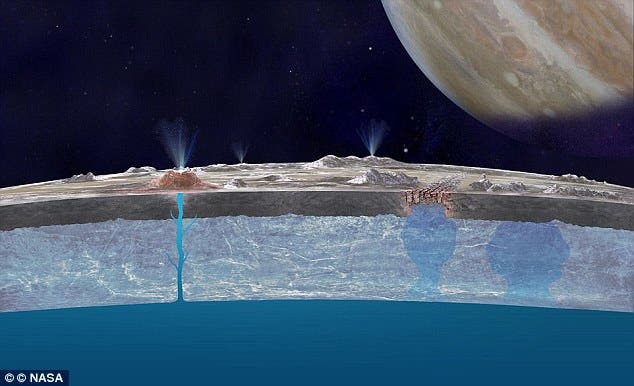If I asked you to guess where we have the best chances of finding life outside of Earth, you’d be hard pressed to think about Europa. But Jupiter’s frozen moon is beginning to look more and more attractive, and may even harbor an Earth-like ocean.

Credits: NASA/JPL-Caltech/ SETI Institute
We’ve written extensively before about the life harboring possibilities of Jupiter’s moon, Europa. Beneath the frozen surface, Europa hosts a salty ocean. There are already some indications about the chemistry of that ocean and its life hosting capabilities. Now, a study from researchers at NASA’s Jet Propulsion Laboratory offered even more support for that theory.
The study compared Europa’s potential for producing hydrogen and oxygen with that of Earth, through processes that do not directly involve volcanism. The balance of these processes gives a key indication about the energy available in the system, energy that would be available for life to harvest. The study found that the amounts would be comparable in scale; on both worlds, oxygen production is about 10 times higher than hydrogen production. This means that the oceans on Europa may be very similar to the oceans on Earth, which in turn means that the rocky core of the satellite may be more complex and Earth-like than we previously thought.
[panel style=”panel-success” title=”Life on Europa” footer=””]- Jupiter’s satellite Europa has a liquid ocean beneath its frozen surface
– Europa’s ocean has similar chemical and energy characteristics to that of Earth
– This may hint at the satellite’s life-bearing possibilities, but this is only a piece of a bigger puzzle.[/panel]
Steve Vance, a planetary scientist at JPL and lead author of the study declared:
“We’re studying an alien ocean using methods developed to understand the movement of energy and nutrients in Earth’s own systems. The cycling of oxygen and hydrogen in Europa’s ocean will be a major driver for Europa’s ocean chemistry and any life there, just as it is on Earth.
Of course, this is only one piece of a bigger puzzle – but it’s a very intriguing piece. Europa is thought to have a hot, iron core and an ocean underneath its thick crust of ice on the surface. Despite the cold temperatures on the surface of the planet, measurements indicate that the ocean is not only liquid, but actually warm, heated by the tidal stresses exerted on Europa by Jupiter as well as by radioactivity. The required substances and elements to harbor life are mixed and flowed through the ocean by the same powerful currents. So all in all, there’s a very good environment with a lot of potential of fostering life – quite possibly the best one we have in the solar system.
“The oxidants from the ice are like the positive terminal of a battery, and the chemicals from the seafloor, called reductants, are like the negative terminal,” said planetary scientist Kevin Hand, also from JPL. “Whether or not life and biological processes complete the circuit is part of what motivates our exploration of Europa.”

There is also a very active water circuit, on a tectonic level. We know this because the icy crust on the surface lacks signs of impact craters, which means it’s constantly renewed. This process doesn’t require any volcanic activity.
“… if the rock is cold, it’s easier to fracture,” said Vance. “This allows for a huge amount of hydrogen to be produced by serpentinization that would balance the oxidants in a ratio comparable to that in Earth’s oceans.”
These tantalizing studies make a clear case for life-favoring conditions, but there are still plenty of factors which could paint an unfavorable picture for life to emerge. This is why we need to get a mission to Europa, to get some first-hand informations and get a clearer idea of whether this frozen satellite is as barren as we once thought, or if it is a hidden oasis of life.


